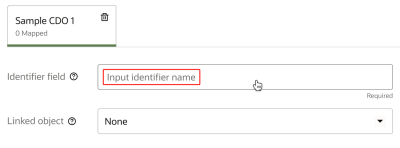Configuring an Oracle Eloqua destination for Next best recommendations
Once you create the custom contact fields in Oracle Eloqua, you can create the Eloqua destination in Oracle Unity.
You will need to set up a template of field mapping between Oracle Unity and Eloqua data.
To create the Eloqua destination:
-
Click the Oracle icon
 in the bottom-right corner to open the navigation menu.
in the bottom-right corner to open the navigation menu.
- Select Destinations.
- In the top-right corner, click Create destination.
Step 1: Define destination details
The job details section allows you to define the type of destination and how it will display in Oracle Unity.
Enter the information for the destination.
- Type: Use the drop-down list to select Eloqua.
- Name: Enter a name. The name must be 1 or more characters, up to a maximum of 50. Use only letters (a–z and A–Z), numbers (0–9), underscores (_), hyphens (-), and spaces. The first character cannot be a space.
-
Destination ID: The unique system identifier that is auto-populated from the destination name you enter. You can't change this value after you create the destination.
- Description: Enter a description. This field is optional, but it is highly recommended to add descriptions for any entity created. This helps all other users get additional context when using and navigating Oracle Unity. The description can have a maximum of 512 characters with no restrictions on characters used. You can use characters from all languages supported in the language settings.
Step 2: Configure authentication settings
Enter the information to allow Oracle Unity to access the required data.
- Company name: Enter the company name you use to log in to Eloqua.
- URL: Enter the base URL for your Eloqua instance. Learn more about Determining base URLs topic from the the Eloqua Developer Help Center.
- Username: Enter the username to access the URL.
- Password: Enter the password to access the URL.
Once you enter all the details, click Verify connection to ensure that Oracle Unity can access the destination.
If there are connection issues, ensure the base URL entered and login credentials are correct.
Step 3: Field mapping
This section allow you to set up a field mapping template for the next best recommendation job that will use the destination.
To set up field mapping:
- For Eloqua object, select the Contact Eloqua object. Then, click Add
 .
. - For Identifier field, enter Email address, which is the Eloqua email contact field in the Contact object. This field will be used as the primary key for the Contact object. You must also make sure the Email attribute is included as a Personalization attribute for the segment you want to export. If this attribute is not included, then the segment will not be exported successfully to Eloqua.
Do not complete the Field mappings section. After creating the accompanying Next best action job or Next best offer job, field mapping will be automatically configured between Oracle Unity Next best recommendation attributes and Eloqua contact fields.
Step 4: Save and publish the new destination
When finished defining the destination, scroll to the top of the page and click Save or Save and close.
Once you create the destination, you will need to publish the changes.
After publishing the changes, you can run do the following:
-
Follow the steps for Creating Next best actions or Creating Next best offers. After saving the Next best action job or Next best offer job, field mapping will be automatically configured between Oracle Unity Next best recommendation attributes and Eloqua contact fields.
-
Run the corresponding job either as a recurring job or on demand.
-
Search and view contact records in Eloqua to verify the data was successfully for all the fields you created.



